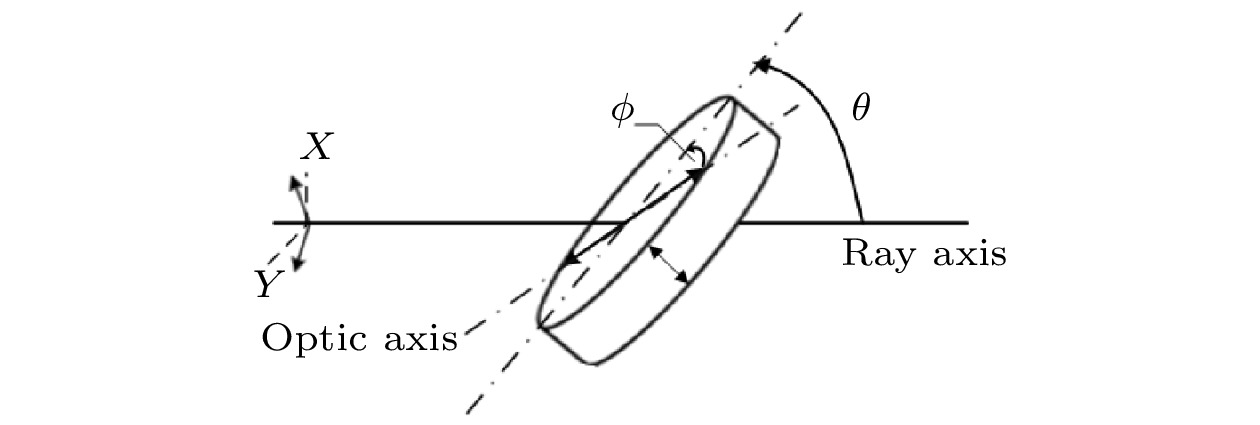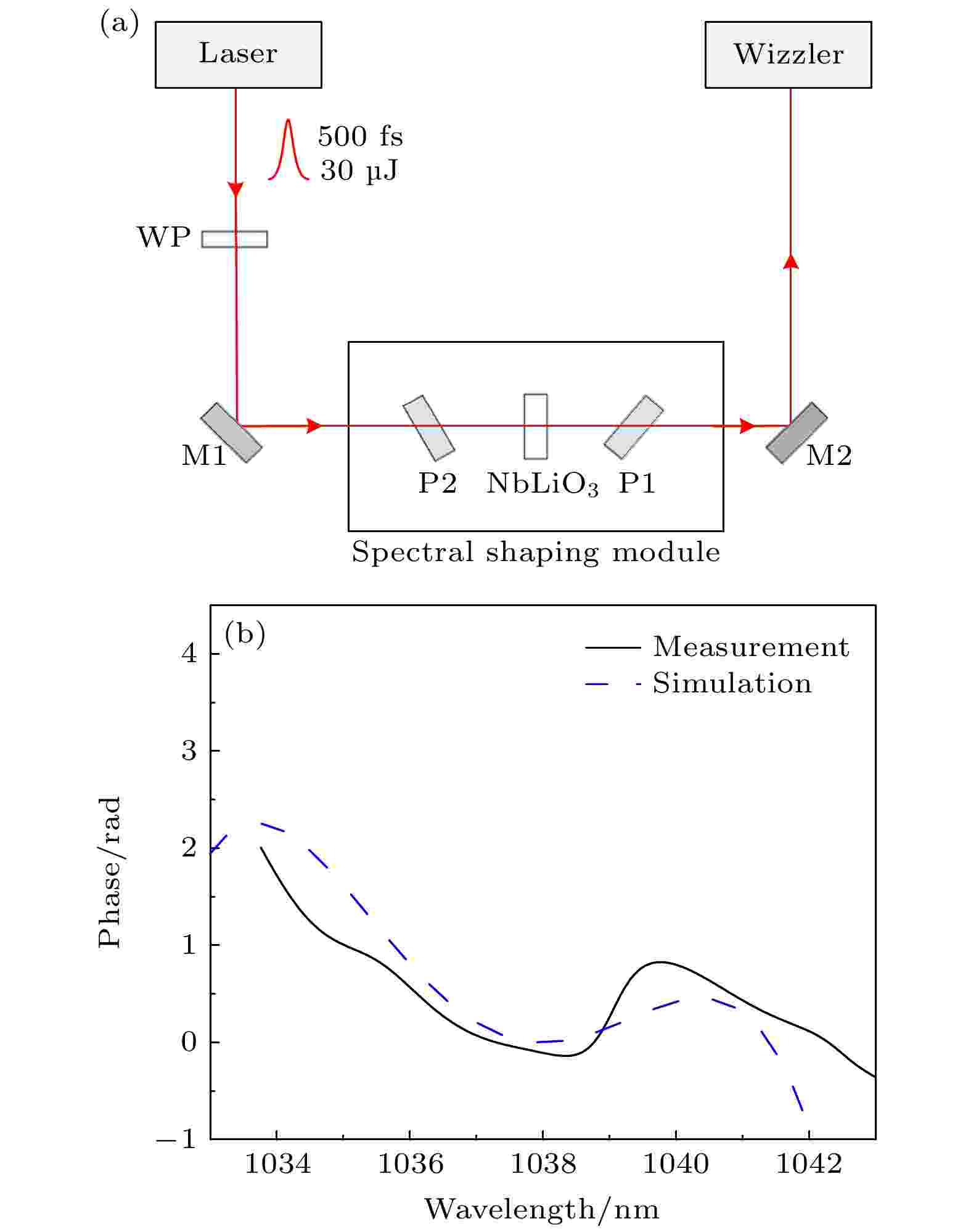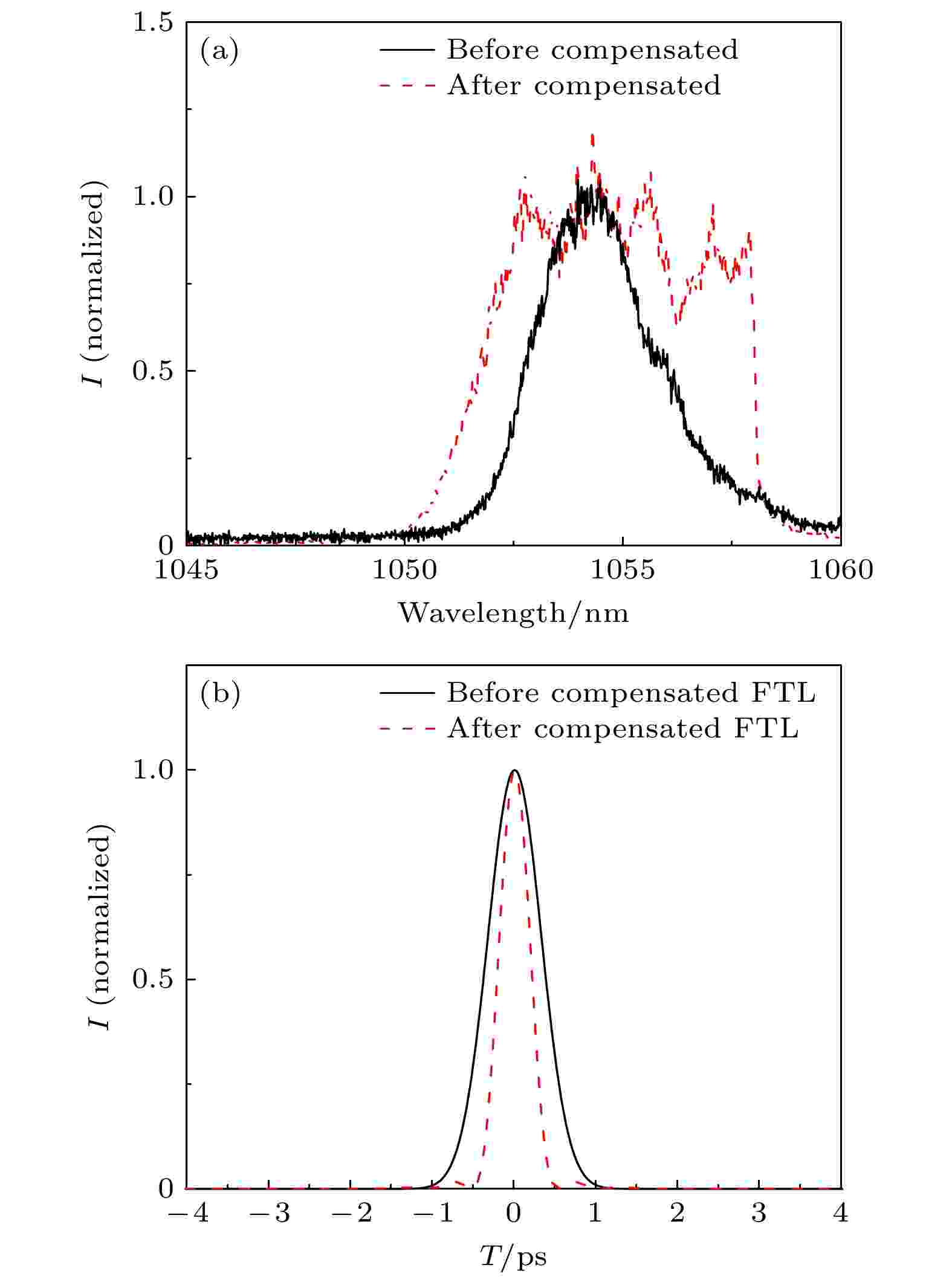全文HTML
--> --> -->目前, 常用的光谱整形技术有: 空间光调制器(spatial light modulator, SLM)[10,11]、声光可编程色散滤波器(acouto-optic programmable dispersive filter, AOPDF)[12]、抽运光整形[13]和双折射晶体整形[14]等. 由于SLM和AOPDF损伤阈值较低, 两者仅能支持小能量的光谱整形; 而在光参量啁啾脉冲放大(optical parametric chirped pulse amplification, OPCPA)中, 通过抽运光间接整形, 虽然可以支持高能量输出, 但增加了抽运光的制备难度, 同时会使OPCPA效率降低; 因此, 具备损伤阈值高、插入损耗小、使用方便等特点的双折射晶体, 被广泛应用于光谱整形中. 针对800 nm激光, 使用石英双折射晶体抑制增益窄化的光谱整形已趋于成熟, 例如: 1996年Bart等[15]将石英平板插入钛宝石再生放大器中, 将光谱半高全宽(full width at half maximum, FWHM)从32 nm展宽到45 nm; 类似地, 2007年陆效明等[16]利用761 μm厚石英平板, 将光谱从28 nm展宽到62 nm. 相对于钛宝石, 易获得大口径、高光学质量的钕玻璃(中心波长1053 nm)更适合于高能量输出, 但是, 它的受激发射截面带宽仅为20 nm[17], 增益窄化效应更为严重, 更难补偿. 近来, 针对1053 nm的双折射光谱整形报道较少, 美国NIF装置[18,19]于2012年对钕玻璃作为增益介质的再生放大器, 使用石英晶体将光谱从3 nm(FWHM)展宽到5 nm; 2003年国内朱鹏飞等[20]使用12 mm厚石英对钕玻璃增益窄化进行补偿, 将光谱从13 nm(FWHM)展宽到15 nm, 展宽效果不明显. 上述报道中, 无论是针对钛宝石还是钕玻璃的双折射晶体光谱整形, 均未对整形过程中晶体引入的光谱相位[21]进行分析. 随着脉冲压缩、相干组束、高信噪比输出等对光谱相位的要求越来越高, 对晶体引入的光谱相位进行分析具有重要意义. 此外, 国内高能拍瓦激光系统为获得更高能量、更短脉宽的高功率输出, 也急需开展针对1053 nm抑制钕玻璃增益窄化的光谱整形工作.
本文针对高能拍瓦激光系统中钕玻璃的增益窄化, 提出了一种基于铌酸锂双折射晶体的高能量光谱整形方法. 在理论上, 从双折射晶体严格琼斯矩阵[22]出发, 研究了晶体厚度、倾斜角、面内旋转角对光谱强度调制和晶体引入相位的影响, 首次模拟了晶体引入的各阶色散量随晶体厚度、倾斜角、面内旋转角的变化情况, 发现通过上述参数可对晶体引入的各阶色散量进行控制. 在此基础上, 搭建了光谱整形模块, 利用神光Ⅱ高能拍瓦激光系统, 有效补偿了钕玻璃放大的增益窄化效应, 在国内首次实现了1700 J, 6 nm (FWHM)的高能宽带激光输出, 是未整形时3.2 nm的2倍. 并开展实验对晶体引入的光谱相位进行测量, 实验与理论模拟相一致. 本文结果将为双折射晶体光谱整形中晶体的参数设计, 材料选择及后续光谱相位补偿提供依据, 也可为高能拍瓦激光系统信噪比的提升提供参考.
式中δo, δe分别为o光、e光通过双折射晶体后的相位改变量, 由下式表示:
 图 1 倾斜双折射平板的厚度t、倾斜角θ和面内旋转角?示意图[14]
图 1 倾斜双折射平板的厚度t、倾斜角θ和面内旋转角?示意图[14]Figure1. Schematic diagram of the thickness t, tilt angle θ, and in-plane rotation angle ? of the tilted birefringent plate[14].
双折射晶体作为滤波元件, 要求入射光为TM (transverse magnetic mode, TM)偏振, 对于单位振幅入射光, 平板后表面的透射光为

将(7)式光谱相位在中心频率ω0处泰勒展开为





2
2.1.光谱整形的强度和相位调制分析
双折射晶体通过在放大介质增益中心波长处增加损耗来抑制增益窄化效应, 即双折射晶体透过率函数在放大介质增益线型的中心波长处透过率低, 在中心波长两侧, 增益相对较小处透过率高, 以此来补偿放大过程中的增益窄化.从(6)式可以看出, 透过率函数除了与晶体厚度t、倾斜角θ、面内旋转角?有关外, 还与晶体主折射no和ne有关, 因此, 本文对BBO、铌酸锂(LiNbO3)和石英(quartz) 3种不同双折射晶体进行了对比. 三者的双折射率如图2(a)所示, 双折射率由大到小依次为BBO、铌酸锂、石英. 在实现如图2(b)的强度调制时, BBO、铌酸锂、石英的厚度t依次为1.0, 1.5, 13.5 mm. 由此可见, 当强度调制相同时, 晶体双折射率越高, 所需厚度越小.
 图 2 BBO、铌酸锂(LiNbO3)和石英(quartz) 3种晶体的对比图 (a) 3种晶体的双折射率曲线; (b) 3种晶体实现相同强度调制的透过率曲线
图 2 BBO、铌酸锂(LiNbO3)和石英(quartz) 3种晶体的对比图 (a) 3种晶体的双折射率曲线; (b) 3种晶体实现相同强度调制的透过率曲线Figure2. Comparison graph of three crystals of BBO, LiNbO3, and quartz: (a) The birefringence curves of three crystals; (b) the transmittance curves of the three kinds of crystals achieve the same intensity modulation.
针对1053 nm激光脉冲, 本文选用了双折射率大于石英的铌酸锂作为分析和实验材料, 相对BBO晶体, 铌酸锂易大口径生长且不易潮解. 本文数值模拟了晶体透过率函数随厚度t、倾斜角θ、面内旋转角?的变化情况, 并同时分析了各参数对晶体引入的光谱相位的影响.
透过率函数和晶体引入的光谱总相位随厚度t变化的曲线如图3(a)所示, 可见, 晶体厚度对透过率函数的调制中心位置及调制带宽均影响明显, 但对调制深度无明显影响. 同时, 随着t的增大, 晶体引入的光谱总相位变大. 为进一步分析总相位中各阶相位的变化规律, 运用(8)式进一步计算了GVD, GDD, TOD, FOD随t变化的曲线. 如图3(b)所示, GVD随厚度在104 fs量级变化, 其余各阶色散随厚度t高频率振荡, 且振荡幅值随厚度t增大. 在厚度为1.5 mm附近时, GDD, TOD, FOD分别在 ± 105 fs2, ± 108 fs3, ± 1011 fs4区间内振荡.
 图 3 当θ = 85°, ? = 30°, t = 1.0, 1.5, 2.0 mm时, 透过率函数、晶体引入的光谱总相位及各阶色散的变化曲线 (a) t = 1.0, 1.5, 2.0 mm时, 透过率函数、光谱总相位随波长的变化曲线; (b) GVD, GDD, TOD, FOD随厚度t的变化
图 3 当θ = 85°, ? = 30°, t = 1.0, 1.5, 2.0 mm时, 透过率函数、晶体引入的光谱总相位及各阶色散的变化曲线 (a) t = 1.0, 1.5, 2.0 mm时, 透过率函数、光谱总相位随波长的变化曲线; (b) GVD, GDD, TOD, FOD随厚度t的变化Figure3. The curve of transmittance function, total phase of the spectrum, and each order dispersion introduced by the crystal with θ = 85°, ? = 30°, t = 1.0, 1.5, 2.0 mm: (a) The transmittance function and total phase of spectrum changes with wavelength; (b) GVD, GDD, TOD, FOD changes with thickness t.
类似地, 倾斜角θ对透过率函数和晶体引入光谱总相位的影响如图4(a)所示, 可见, 透过率函数的衰减中心位置随θ变化明显, 但调制深度及带宽无明显变化. 此外, 晶体引入的光谱总相位随倾斜角θ变化不明显, 这主要是由于GVD的影响. 为了进一步研究θ对高阶相位的影响, 对光谱总相位进行泰勒展开, 得到高阶色散随θ变化情况, 如图4(b)所示, 各级色散随θ周期振荡, GDD, TOD, FOD的振荡范围分别为 ± 105, ± 107, ± 1011 fs4.
 图 4 当? = 30°, t = 1.5 mm, θ = 80°, 85°, 90°时, 透过率函数、晶体引入的光谱总相位及各阶色散的变化曲线 (a) 透过率函数、光谱总相位随波长的变化曲线; (b) GVD, GDD, TOD, FOD随厚度θ的变化
图 4 当? = 30°, t = 1.5 mm, θ = 80°, 85°, 90°时, 透过率函数、晶体引入的光谱总相位及各阶色散的变化曲线 (a) 透过率函数、光谱总相位随波长的变化曲线; (b) GVD, GDD, TOD, FOD随厚度θ的变化Figure4. The curve of transmittance function, total phase of the spectrum and each order dispersion introduced by the crystal with ? = 30°, t = 1.5 mm, θ = 80°, 85°, 90°: (a) The transmittance function and total phase of spectrum changes with wavelength; (b) GVD, GDD, TOD, FOD changes with thickness θ.
同样地, 透过率函数与晶体引入的光谱总相位随参数?的变化曲线如图5(a)所示, 可以看出, 随着?的变化透过率函数的调制深度发生明显变化, 衰减中心、调制带宽变化不明显, 由?取不同值时引入光谱总相位的对比可以看出, 光谱总相位随?变化不明显, 这同样是由于GVD的影响. 如图5(b)所示, 各阶色散量随?的变化, 起伏较为平缓, 如在?从25°变化到35°的过程中, FOD变化了3 × 1011 fs4.
 图 5 当θ = 85°, t = 1.5 mm, ? = 25°, 30°, 35°时, 透过率函数、晶体引入的光谱总相位及各阶色散的变化曲线 (a) 透过率函数、光谱总相位随波长的变化曲线; (b) GVD, GDD, TOD, FOD随厚度?的变化
图 5 当θ = 85°, t = 1.5 mm, ? = 25°, 30°, 35°时, 透过率函数、晶体引入的光谱总相位及各阶色散的变化曲线 (a) 透过率函数、光谱总相位随波长的变化曲线; (b) GVD, GDD, TOD, FOD随厚度?的变化Figure5. The curve of transmittance function, total phase of the spectrum, and each order dispersion introduced by the crystal with θ = 85°, t = 1.5 mm, ? = 25°, 30°, 35°: (a) The transmittance function and total phase of spectrum changes with wavelength; (b) GVD, GDD, TOD, FOD changes with thickness ?.
综上所述, 透过率函数的调制深度受面内旋转角?影响, 衰减中心的位置由倾斜角θ控制, 调制带宽由厚度t决定. 引入的光谱总相位随晶体厚度变化显著, 且厚度越大引入的总相位越大, 倾斜角θ、面内旋转角?对光谱总相位影响不明显. 此外, 高阶色散均可由厚度t、倾斜角θ、面内旋转角?进行控制, 其中对厚度t的变化最敏感.
2
2.2.相位调制对时域脉冲的影响分析
由上述分析可以看出, 在激光放大链路中插入双折射晶体, 对光谱强度进行整形的同时, 还会产生附加相位调制. 随着各阶相位的引入, 对光束的脉宽、信噪比等均可能产生影响. 本文对光谱整形过程中双折射晶体引入的光谱相位对时域脉冲的影响进行了模拟分析.以理想高斯信号为例, 在频域加入双折射晶体引入的各阶光谱相位:
根据2.1节中各阶色散随晶体各参数的变化情况, 在晶体厚度为1.5 mm附近调节晶体各参数, 控制晶体引入的四阶色散分别取正最大1.4 × 1011 fs4、负最大–1.4 × 1011 fs4及0 fs4, 3种情况下, 晶体引入的三、四阶相位如图6所示.
 图 6 双折射晶体引入的三、四阶相位 (a) 三阶相位; (b) 四阶相位
图 6 双折射晶体引入的三、四阶相位 (a) 三阶相位; (b) 四阶相位Figure6. Third and fourth order phase introduced by birefringent crystal: (a) Third order phase; (b) fourth order phase.
运用(9)式分别将图6中的三阶、四阶相位之和加入到中心波长为1053 nm、脉宽为230 fs、光谱宽度为6.5 nm (FWHM)的高斯信号中, 对时域脉冲的影响结果如图7所示.
 图 7 在高斯信号中加入三、四阶相位后的时域脉冲图 (a) 线性坐标时域图; (b)对数坐标时域图
图 7 在高斯信号中加入三、四阶相位后的时域脉冲图 (a) 线性坐标时域图; (b)对数坐标时域图Figure7. Time-domain pulse diagram of third and fourth order phase added to Gaussian signal: (a) Linear coordinate time domain diagram; (b) logarithmic coordinate time domain diagram.
可以看出, 当四阶色散取正最大值和负最大值时, 对脉冲有明显的调制作用, 并使脉冲信噪比下降到10–5量级; 当四阶色散取零时, 三阶色散的影响得以显现, 使信噪比成不对称性下降; 此外, 四阶色散正最大与负最大对脉冲信噪比的影响几乎相同.
在神光Ⅱ高能拍瓦激光系统中, 由于钕玻璃放大过程中的B积分累积, 将系统信噪比限制在10–9量级; 展宽器、压缩器引起的光谱剪切, 将信噪比限制在10–11量级[23]; 展宽器、压缩器光栅带来的散射噪声和OPCPA的参量荧光会将数十皮秒外的信噪比限制在10–8量级. 此外, 展宽器和压缩器的剩余三、四阶色散量分别在107 fs3, 109 fs4量级, 其他材料引入的各阶色散在105量级以下[24], 由上述模拟计算得到, 1.5 mm厚的铌酸锂晶体, 引入的三、四阶色散量极值分别在108 fs3, 1011 fs4量级, 由此可以看出, 当双折射晶体处于高阶色散量极值状态时, 将成为影响系统脉冲信噪比的限制因素. 因此, 在整形过程中, 需要通过调节参数来控制晶体引入的高阶色散, 以减小双折射晶体对系统信噪比的影响.
 图 8 皮秒拍瓦激光系统装置框图及注入钕玻璃放大系统前的预补偿光谱图 (a) 神光Ⅱ高能拍瓦激光系统装置框图[23]; (b) 强度调制前后注入钕玻璃放大系统前的预补偿光谱实验和模拟图
图 8 皮秒拍瓦激光系统装置框图及注入钕玻璃放大系统前的预补偿光谱图 (a) 神光Ⅱ高能拍瓦激光系统装置框图[23]; (b) 强度调制前后注入钕玻璃放大系统前的预补偿光谱实验和模拟图Figure8. Block diagram of picosecond petawatt laser system and pre-compensation spectrum before injection of Nb:glass amplifier system: (a) Block diagram of ShenguangⅡhigh-energy petawatt laser system[23]; (b) pre-compensation spectrum experiment and simulation diagram before and after intensity modulation before injection of Nb:glass amplifier system.
如图9(a)中的光谱整形模块, 由偏振片P1, P2及铌酸锂晶体组成, 其中偏振片P1, P2透过偏振均为TM偏振. 根据强度调制的理论分析, 设置铌酸锂晶体参数为t = 1.5 mm, θ = 86°, ? = 31°, 开展了中心波长为1053 nm、调制带宽10 nm、调制深度80%的光谱整形实验. 脉冲由OPCPA输出后, 经光谱整形模块得到的预补偿光谱如图8(b)所示, 其中黑色实线是未经整形的实验测量值, 黑色虚线是对应的模拟值, 红色实线是整形后的实验测量值, 红色虚线为模拟值, 与补偿前相比, 在中心波长处形成深度80%的调制, 且实验与模拟结果拟合良好.
 图 9 相位测量实验光路图及相位测量结果 (a) 相位测量实验光路图; (b)晶体引入相位的实验测量与模拟图
图 9 相位测量实验光路图及相位测量结果 (a) 相位测量实验光路图; (b)晶体引入相位的实验测量与模拟图Figure9. Beam path diagram of phase measurement experiment and phase measurement results: (a) Beam path diagram of phase measurement experiment; (b) experimental measurement and simulation diagram of the phase introduced by the crystal.
同时为进一步研究整形过程中晶体引入的光谱相位, 本文设计实验使用Wizzler对光谱相位进行了测量. 光路如图9(a)所示, 激光脉冲由500 fs, 30 μJ, 1038 nm激光器输出后, 经过波片WP (wave plate, WP)、反射镜M1进入光谱整形模块, 后经反射镜M2进入Wizzler进行光谱相位测量, 其中波片WP用于控制进入Wizzler的脉冲能量. 本文分别对不放入晶体及晶体处于上述强度整形状态时的各阶光谱相位进行测量, 两种状态所测数值做差, 进而得到晶体自身引入的各阶光谱相位, 其中光谱相位测量值如图9(b)实线所示. 实验中晶体实际厚度为1.5018 mm, θ = 86°, ? = 31°. 为了更好地分析实验测量相位, 拟合中保留至五阶色散, 模拟结果如图9(b)所示, 可以看出, 模拟值与实验测量值变化趋势相同, 远离中心波长的偏差主要是由于相位拟合过程中忽略了高阶项引起的. 该实验验证了本文中对双折射晶体引入的相位及各阶色散计算方法的准确性.
针对神光Ⅱ高能拍瓦激光系统, 光谱整形模块插入前后经钕玻璃放大系统输出的光谱如图10(a)所示, 其中黑色实线是整形前的输出光谱图, 红色虚线是整形后的输出光谱图, 通过两者对比可以看出, 整形后光谱展宽2倍, 该实验在国内首次实现了1700 J, 6 nm (FWHM)激光输出. 图9(b)为输出光谱所能支持的傅里叶变换极限脉冲比较图, 可见, 补偿增益窄化后时域脉冲傅里叶变换极限由800 fs (FWHM)减小到400 fs, 这将使聚焦功率密度增加1倍, 在技术上解决压缩光栅的能量受限问题之后, 将对神光Ⅱ高能拍瓦激光系统的性能提升具有重要意义.
 图 10 补偿增益窄化前后的输出光谱图与傅里叶变换极限脉冲比较图 (a) 补偿增益窄化与未补偿增益窄化的输出光谱实验图; (b) 补偿增益窄化与未补偿增益窄化的傅里叶变换极限脉冲
图 10 补偿增益窄化前后的输出光谱图与傅里叶变换极限脉冲比较图 (a) 补偿增益窄化与未补偿增益窄化的输出光谱实验图; (b) 补偿增益窄化与未补偿增益窄化的傅里叶变换极限脉冲Figure10. Comparison of output spectrum and Fourier transform limit pulse before and after compensation gain narrowing: (a) Experimental graphs of output spectra of compensated gain narrowing and uncompensated gain narrowing; (b) the Fourier transform limit pulse with compensated gain narrowing and uncompensated gain narrowing.
本文成功补偿了皮秒拍瓦激光系统中钕玻璃宽带放大引起的增益窄化效应, 实现了高能宽带激光输出, 并首次从相位角度对双折射晶体光谱整形进行了分析, 可以为高能激光的同步、相干组束、高信噪比输出等对光谱相位要求较高的研究领域提供指导, 对国内基于钕玻璃放大的高能拍瓦激光系统的工程研制具有重要意义. 针对双折射晶体引入的高阶色散量对脉冲信噪比影响的情况, 后续将开展实验进行研究.
